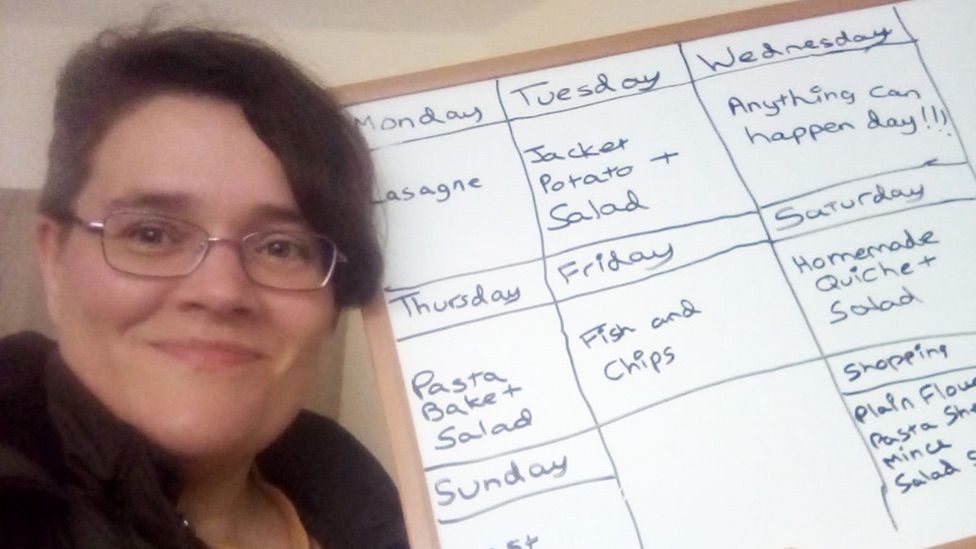ARTICLE AD BOX
 Image source, Jen Butler
Image source, Jen Butler
Jen Butler plans meals days in advance
By Kevin Peachey & Noor Nanji
Cost of living correspondent & business reporter
Faced with a rapid rise in food prices, Jen Butler admits she is "very particular" about planning family meals.
A weekly dinner plan is written up on a whiteboard. Prices are compared between the local Asda and Aldi. Items in the kitchen cupboards are thrown together in an "anything can happen day" meal.
A wide selection of fruit and vegetables are growing in the garden and she even swaps food with the neighbours to save on waste.
"Financially, we always try to go in the right direction, to beat the previous month," says Mrs Butler, a 43-year-old carer.
At the heart of this preparation is a paper shopping list, amended as required when the family decide on groceries for the week ahead.
Written history
List writing is proving popular as the cost of living has soared, helping people to budget and buy what they need rather than what they want. A survey provided exclusively to the BBC by retail data firm Kantar suggested that by the end of last year, 27% of those asked had either started regularly writing, or been making greater use of, shopping lists.
The habit is nothing new. Ancient Mesopotamians created shopping lists using symbols and characters on clay tablets in 3200-2000BC. The Romans did something similar with wax or ink on tablets of wood. Painter Michelangelo drew each item on his list to help his illiterate servant.
The modern equivalent is a task - even an artform - that has been celebrated with a recent exhibition at London's Museum of Brands.
Image source, Museum of Brands/Lucy Ireland Gray
Image caption,Read the list closely for the touching message
It featured Lucy Ireland Gray's collection of about 200 shopping lists that she found discarded over the course of nearly 20 years in and around Hertfordshire, where she lives.
She says they show not only people's shopping needs, but also something of their lives. In one, there is a love message hidden partway down the column of groceries. In another, a child enjoys a joke about her mum, at the same time as illustrating the list.
Image source, Museum of Brands/Lucy Ireland Gray
Image caption,This child's list is full of pictures and jokes
Museum director Anna Terry says there are clear indications of shoppers being mindful about where their money goes by grouping items by meal, and conscious of food waste.
"One of the common reactions from visitors was: 'I must be more organised,'" she says.
"Making a list and having plans is better for personal finances and means less goes in the bin. But you can still see certain brand names [on the lists]. Even in tight times, people won't give up on certain things."
As that exhibition ends, so another begins, one that makes the pressure that families face with the rising cost of groceries crystal clear.
A new display features the top-selling grocery brands of last year, as compiled by The Grocer magazine. Nearly all of the suppliers of the 100 brands featured had put up their prices.
That is reflected in the latest official data. Food prices are rising at their fastest rate in 45 years, according to the Office for National Statistics (ONS).
Intriguingly, the museum itself saw a rise in visitor numbers during the recession of 2008-09, as people paid more attention to what they bought. That was key to a decision during the current financial squeeze to keep its admission prices unchanged.
Anna Terry says the cost of living is a key feature of buying habits
Among the brands, the top 10 was relatively stable compared with the previous year, but Mrs Terry says there had been a clear impact from rising costs. Innovation among brands had slowed and, although there had been more "thoughtful buying" among consumers, there were clear signs that people were still willing to treat those they love.
"Premium pet food had a good year. It seems we still buy the best for our pets, even when we cut back on ourselves," she says.
Nostalgic visitors also point out the trend of shrinkflation - when an item may cost the same, but is smaller than before. "People point and say things were definitely bigger in the past," she says.
Changing deals
Manufacturing dynamics may have changed, but retailers' tactics are also evolving. Elsewhere in the museum, visitors can recall the popularity of Green Shield Stamps.
Under this early loyalty scheme, shoppers filled books of stamps to exchange for gifts. Complete eight books and you could claim a new toaster. A Lambretta scooter was yours for 155 full books.
Loyalty schemes have run along the same lines for years since, but recent announcements suggest Tesco with its Clubcard and the Boots Advantage card are shifting their emphasis to on-the-day discounts of own-brand products.
Such flash offers were around in the 1960s, so perhaps some of the oldest ideas are still the best.
So, when you write a shopping list today, remember you will be repeating a task that has survived for at least 4,000 years.

 2 years ago
57
2 years ago
57








 English (US) ·
English (US) ·